Madeline Wimmer- Fruit Production Extension Educator
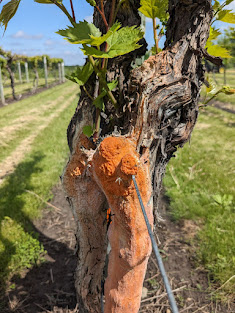
It's not uncommon to see slime molds opportunistically growing on wood chip mulch or other organic mulches in a vineyard, and occasionally one might come upon a slime mold growing on a grapevine, itself. In the second scenario, the slime mold is usually taking advantage of leaking sap for consumption. They tend to be of little concern for growers, but can be a sign of grapevine stress, depending on what has led to the present sap-leaking condition.
Online UMN cold climate grape course
For growers who are new to vineyard and canopy management, keep in mind that UMN offers, "Growing cold climate grapes: Vineyard management," an online course which is currently free and available to support new grape growers. This course offers support for many stages and aspects of vineyard management, including planting and training, as well as integrated pest management topics.
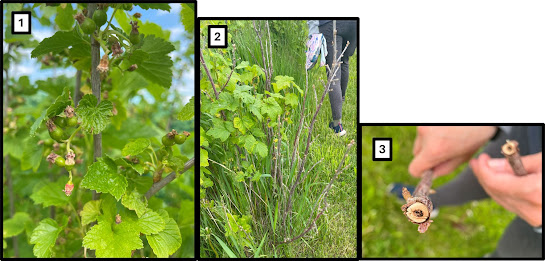 Images: 1)Black currant shrub showing fruit set, 2) a black currant shrub with damaged canes, 3) evidence of damage likely caused by currant borer. Photos taken at Blue Fruit Farm, an organic diversified fruit farm near Winona, MN (Zone 5a).
Images: 1)Black currant shrub showing fruit set, 2) a black currant shrub with damaged canes, 3) evidence of damage likely caused by currant borer. Photos taken at Blue Fruit Farm, an organic diversified fruit farm near Winona, MN (Zone 5a).
About
Black currants (Ribes nigrum) grow as shrubs and produce berries on mature fruiting canes that are then pruned out every four to five years. They are a different species than red, white, and pink currants (R. sativum), and are part of the heritage of Jostaberries (R. nigrum X R. hirtellum), which were bred from a cross between gooseberries and black currants. Black currant berries can be eaten fresh or processed and the leaves are used for tea in some traditions.
This fruit update contains information about…
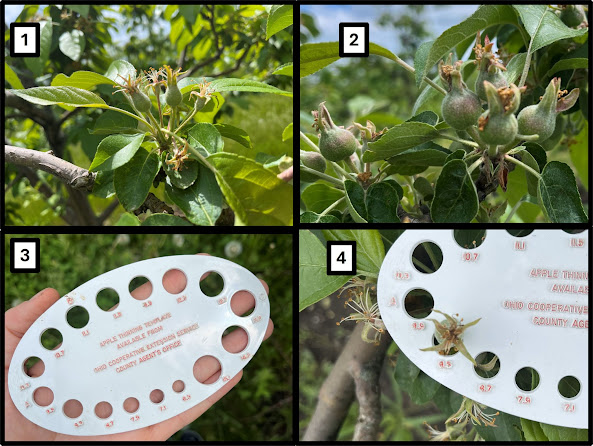
Similar to how bloom times vary, apple growth rates are not the same across varieties. Zestar!®, shown above, is on average ahead of Minneiska (SweeTango®) and is also known for early harvesting.
This week at the University of Minnesota Horticulture Research Center (UMN HRC), many apples have reached between 9-13mm in diameter, which was measured using a simple apple thinning template. As mentioned in last week’s update, after apples reach a specific diameter in growth, many chemical thinning tactics tend to go down in efficacy.
- Apples- growth stage, & insect and disease management
- Grapes- growth stage, canopy management, and insect & disease management, note on slime molds in the vineyard, and UMN online grape course.
- Black currants- about, growth stage, and currant borer management.
- Northeastern Minnesota fruit gallery
Apples
Images: 1) Minneiska (SweeTango®) fruits at 9-10mm in diameter, 2) Zestar!® fruits at 11.5-12.5mm in diameter, 3) an example of an apple thinning template, and 4) Minneiska (SweeTango®) fruit passing through the 9.5 mm hole on the apple thinning template; pictures taken at the UMN Horticulture Research Center near Chaska, Minnesota (Zone 5a; pictures taken by Kate Scapanski, UMN Apple Researcher.)
Growth stage Similar to how bloom times vary, apple growth rates are not the same across varieties. Zestar!®, shown above, is on average ahead of Minneiska (SweeTango®) and is also known for early harvesting.
This week at the University of Minnesota Horticulture Research Center (UMN HRC), many apples have reached between 9-13mm in diameter, which was measured using a simple apple thinning template. As mentioned in last week’s update, after apples reach a specific diameter in growth, many chemical thinning tactics tend to go down in efficacy.
Fungal diseases
Mature apple scab spores, known as ascospores, are at their highest presence from pink growth stage to the end of bloom; and one to two weeks after the final petal fall most ascospores have finished being released.
For the UMN HRC, the Cornell NEWA forecasting tool indicates that primary scab season has passed as of now, based on a reported green tip date occurring on 03/30/2024. Primary scab refers to infections from overwintering fungal fruiting bodies, whereas secondary scab is caused by foliar lesions, and both are important to manage. As of now, if foliar lesions are present, apple scab will continue to be a risk around wetting/rain events
Mature apple scab spores, known as ascospores, are at their highest presence from pink growth stage to the end of bloom; and one to two weeks after the final petal fall most ascospores have finished being released.
For the UMN HRC, the Cornell NEWA forecasting tool indicates that primary scab season has passed as of now, based on a reported green tip date occurring on 03/30/2024. Primary scab refers to infections from overwintering fungal fruiting bodies, whereas secondary scab is caused by foliar lesions, and both are important to manage. As of now, if foliar lesions are present, apple scab will continue to be a risk around wetting/rain events
Insect pests
Plum curculio: In last week’s update, I mentioned that if plum curculio is present, management is generally recommended until 308 degree days have accumulated post petal fall. At the UMN HRC, the last petal fall was 05/18/2024 and since then, 66 degree days have accumulated, and thus management continues. Keep in mind that your last petal fall also varies between varieties. Online growing degree day calculators can be used as a tool for growers who are interested in referring to degree day accumulations to estimate insect growth stages and events in their region. On-site weather stations are also available to record local temperatures, which can then be uploaded into an excel spreadsheet to calculate degree day accumulations.
Apple codling moth: There were a few reports for apple codling moths' first catch in Washington and Wright County around 05/15/2024, according to the MDA’s IPM fruit update. This doesn’t mean that it is not present in other counties in Minnesota and throughout the Upper Midwest, or other orchards in the surrounding area, but is indicative of its activity and growth stage. Because these catch dates are from multiple days prior, catch incidences are likely higher in many counties this week.
Other insect pests: There have also been many reports since 05/15/2024 of redbanded leafroller and spotted tentiform leafminer in multiple counties including Chisago, Washington, and Rice counties based on the MDA fruit update report.
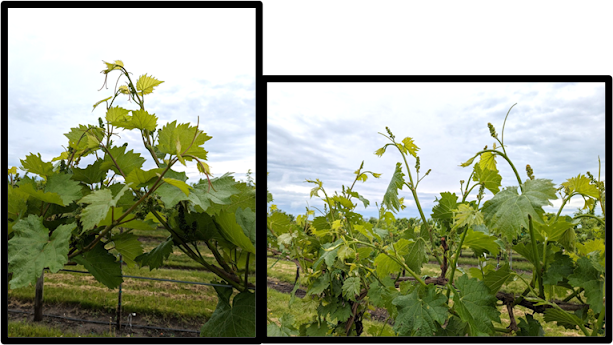 Images: Marquette (left) around 8in shoots and Itasca (right), which is further along in development at the UMN HRC near Chaska, MN (Zone 5a; photo taken by John Thull, UMN Vineyard Manager).
Images: Marquette (left) around 8in shoots and Itasca (right), which is further along in development at the UMN HRC near Chaska, MN (Zone 5a; photo taken by John Thull, UMN Vineyard Manager).
Canopy management
Shoots are beginning to grow past the tenderness stage in which they can easily be thinned by hand. Similarly, when shoots become less tender, other tasks like de-suckering the base of a vine or removing unnecessary watersprouts from the vine trunk will become more difficult.
Renewal spurs: While removing unnecessary watersprout shoots from a vine is necessary, maintaining one renewal spur on each trunk, close to the fruit zone can be helpful insurance for growers who may need to replace damaged or declining cordons. The renewal spur, similar to fruiting spurs, is created from a one-year old cane and replaced when needed. It also offers the advantage for growers who are considering transitioning to cane pruning styles that require such spurs.
Plum curculio: In last week’s update, I mentioned that if plum curculio is present, management is generally recommended until 308 degree days have accumulated post petal fall. At the UMN HRC, the last petal fall was 05/18/2024 and since then, 66 degree days have accumulated, and thus management continues. Keep in mind that your last petal fall also varies between varieties. Online growing degree day calculators can be used as a tool for growers who are interested in referring to degree day accumulations to estimate insect growth stages and events in their region. On-site weather stations are also available to record local temperatures, which can then be uploaded into an excel spreadsheet to calculate degree day accumulations.
Apple codling moth: There were a few reports for apple codling moths' first catch in Washington and Wright County around 05/15/2024, according to the MDA’s IPM fruit update. This doesn’t mean that it is not present in other counties in Minnesota and throughout the Upper Midwest, or other orchards in the surrounding area, but is indicative of its activity and growth stage. Because these catch dates are from multiple days prior, catch incidences are likely higher in many counties this week.
Other insect pests: There have also been many reports since 05/15/2024 of redbanded leafroller and spotted tentiform leafminer in multiple counties including Chisago, Washington, and Rice counties based on the MDA fruit update report.
Grapes
Canopy management
Shoots are beginning to grow past the tenderness stage in which they can easily be thinned by hand. Similarly, when shoots become less tender, other tasks like de-suckering the base of a vine or removing unnecessary watersprouts from the vine trunk will become more difficult.
Renewal spurs: While removing unnecessary watersprout shoots from a vine is necessary, maintaining one renewal spur on each trunk, close to the fruit zone can be helpful insurance for growers who may need to replace damaged or declining cordons. The renewal spur, similar to fruiting spurs, is created from a one-year old cane and replaced when needed. It also offers the advantage for growers who are considering transitioning to cane pruning styles that require such spurs.
Insect pests and diseases
- Last week information regarding foliar grape phylloxera was shared and continues to be a relevant pest for vineyards during this time.
- Growers can continue to follow a general, proactive fungicide program. For more information on developing a grape pesticide application program, refer to the Midwest Fruit Pest Management guide.
Image: An orange slime mold on a wild grape at the UMN Horticulture Research Center near Chaska, MN (Zone 5a; photo taken by John Thull, UMN Vineyard Manager).
Seeing slime molds It's not uncommon to see slime molds opportunistically growing on wood chip mulch or other organic mulches in a vineyard, and occasionally one might come upon a slime mold growing on a grapevine, itself. In the second scenario, the slime mold is usually taking advantage of leaking sap for consumption. They tend to be of little concern for growers, but can be a sign of grapevine stress, depending on what has led to the present sap-leaking condition.
Online UMN cold climate grape course
For growers who are new to vineyard and canopy management, keep in mind that UMN offers, "Growing cold climate grapes: Vineyard management," an online course which is currently free and available to support new grape growers. This course offers support for many stages and aspects of vineyard management, including planting and training, as well as integrated pest management topics.
Black currants
About
Black currants (Ribes nigrum) grow as shrubs and produce berries on mature fruiting canes that are then pruned out every four to five years. They are a different species than red, white, and pink currants (R. sativum), and are part of the heritage of Jostaberries (R. nigrum X R. hirtellum), which were bred from a cross between gooseberries and black currants. Black currant berries can be eaten fresh or processed and the leaves are used for tea in some traditions.
Growth stage
In southeast Minnesota, black currants have finished flowering and set fruit.
In southeast Minnesota, black currants have finished flowering and set fruit.
Currant borer
Currant borer can become a pest for both currants and gooseberries. The currant borer juvenile phase damages canes, which makes it challenging to manage with contact insecticides. One cultural approach to manage currant borers is to practice removing damaged canes from the area and burning or destroying them after pruning, which is what is done at Blue Fruit Farm— an organic diversified fruit farm located near Winona, Minnesota.
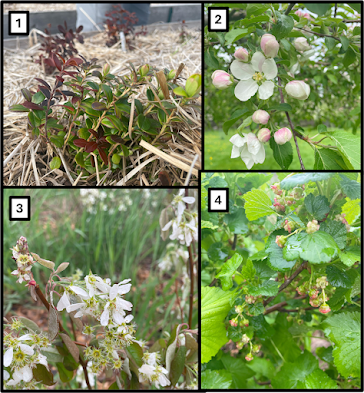
This past week, I was in the Duluth area and had the opportunity to visit multiple fruit farms including The Boreal Farm, Canosia Grove, and Clover Valley Farms, which operate under Zone 4b growing conditions.
Currant borer can become a pest for both currants and gooseberries. The currant borer juvenile phase damages canes, which makes it challenging to manage with contact insecticides. One cultural approach to manage currant borers is to practice removing damaged canes from the area and burning or destroying them after pruning, which is what is done at Blue Fruit Farm— an organic diversified fruit farm located near Winona, Minnesota.
Northeast Minnesota fruit gallery
Images: 1) Lingonberry being grown at The Boreal Farm, 2) Chestnut Crab apple variety beginning to bloom at Canosia Grove 3) blooming serviceberry shrub, and 4) black currant near bloom at Clover Valley Farm— all farms located in different locations near Duluth, MN (Zone 4b.)
While we’ve finished up with apple bloom in our Zone 5 regions in Minnesota, apple bloom is just beginning in the Duluth area. Despite the delay in development and being faced with a shorter growing season, many fruit crops can be grown in northern Minnesota regions including tree fruits—from apples to plums—various shrub crops, and grapevines.
Lingonberry
At The Boreal Farm, lingonberry (Vaccinium vitis-idaea), a low-growing evergreen shrub crop, is being established for production. When the plants reach fruition, they will produce small red berries that have traditionally been used for jam and other value-added goods; and the leaves can also used for tea. For more information on lingonberry production, refer to this University of Massachusetts Extension bulletin.
Lingonberry
At The Boreal Farm, lingonberry (Vaccinium vitis-idaea), a low-growing evergreen shrub crop, is being established for production. When the plants reach fruition, they will produce small red berries that have traditionally been used for jam and other value-added goods; and the leaves can also used for tea. For more information on lingonberry production, refer to this University of Massachusetts Extension bulletin.
Comments
Post a Comment